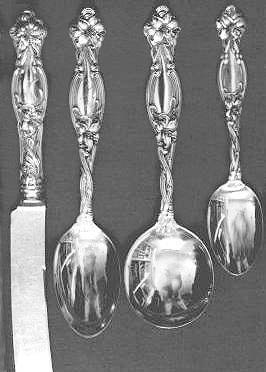|
|
The Collecting Place Settings Forum The forum's posts/subject/threads are closed.
This forum can only be viewed |
|
How to Post Photos
Want to be a Moderator?
|
|
|
The Collecting Place Settings Forum The forum's posts/subject/threads are closed.
This forum can only be viewed |
|
How to Post Photos
Want to be a Moderator?
|

|
 SMP Silver Salon Forums SMP Silver Salon Forums
  Collecting Place Settings Collecting Place Settings
  International Frontenac 1903 International Frontenac 1903
|
| next newest topic | next oldest topic |
| Author | Topic: International Frontenac 1903 |
|
Bob Schulhof Posts: 194 |
  
Frontenac (1903) International (Simpson Hall & Miller) The material for this post was supplied by members Jim & Hester [southerncross@erols.com].  Special Features Dating I examined 40 place & serving pieces and compared whether 'sterling' was boxed or not, if a patent stamp was used and if so was it 'PAT. or PAT'D ', whether the shield under the knight's head was an outlined area with a raised 'S' or a solid area with the 'S' impressed, the clarity of the plant stamens, anthers & stigma, and whether or not there were raised spots on the lilies. No definitive pattern emerged. All but 2 pieces (knives excluded) had patent marks of some sort. Surprisingly, one that didn't was a pierced jelly cake server which is so finely pierced that I can't imagine it being a newer piece; the manufacturing/finishing cost would be enormous plus I don't think it was a utensil that was in heavy demand. The other was the above pie fork. In most cases, 'PAT'D' was used in conjunction with a raised 'S' in the outlined shield mark and a boxed 'STERLING', and 'PAT.' was used with an impressed 'S' in a solid shield and usually no box, but enough exceptions occurred to prevent this from being conclusive. Details on the lilies' anthers & stigmas had some minute variations under a loupe, but not enough to criticize - probably just different finishers - and the spots were heavy on some pieces, moderate on others, and almost non-existent on a few, following no apparent pattern. Does anyone have any verified method of dating? Pieces Available Photo Place pieces: Serving Pieces Key Pieces comments Other Questions From teaspoon to tablespoons, all that I've seen have been thin and inadequate to use without fear of bending. The weight of the smaller spoons (5 o'clock & smaller) are relative to their size and use, but the teas, soups and tablespoons are pathetic. Do heavy spoons exist? Why would a company that manufactured such an ornate, complex pattern with heavy forks and serving pieces manufacture spoons that are a joke? IP: Logged |
|
M H Bradshaw Posts: 32 |
  
Thanks for the editing, Bob. Turner's doesn't list the pattern as being obsolete, but has it been in continuous production since 1903? I always assumed production was restarted in the '70s or '80s. Hester IP: Logged |
|
Bob Schulhof Posts: 194 |
  
You are making a very important point that is worth a discussion. I have been making the assumption that if Turner does not show it as obsolete and it is still being made that they never stopped. It is interesting that Hagan does not list it as "Currently in Production" so possibly it did restart recently. I am a relative neophyte at silver collecting and it may have been that a number of old patterns were revived in the 1970's or 1980's. Does anyone know? IP: Logged |
All times are ET | next newest topic | next oldest topic |
  |
|
Ultimate Bulletin Board 5.46a
|
copyright © 1993-2022
SM Publications
All Rights Reserved. Legal & Privacy Notices |